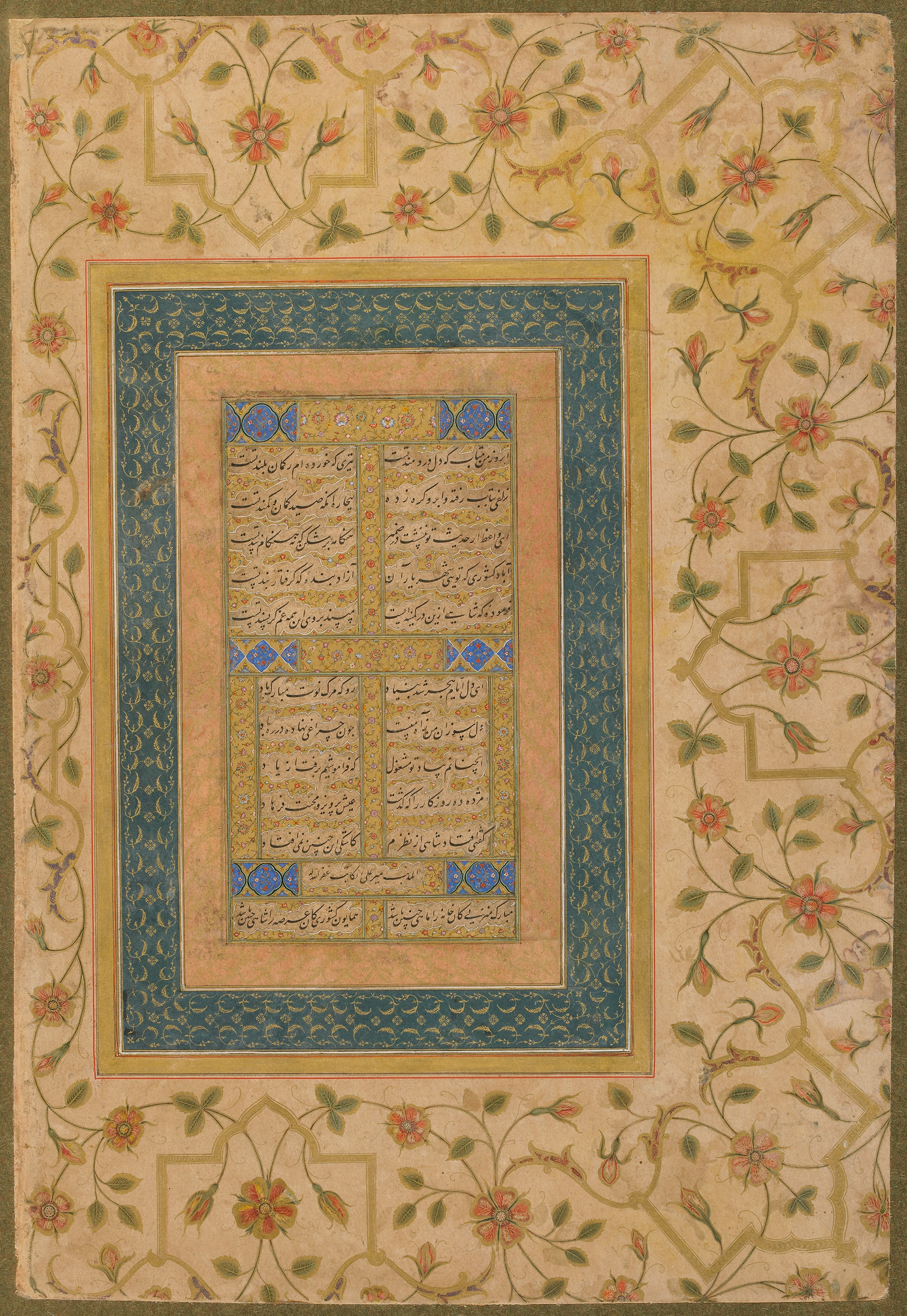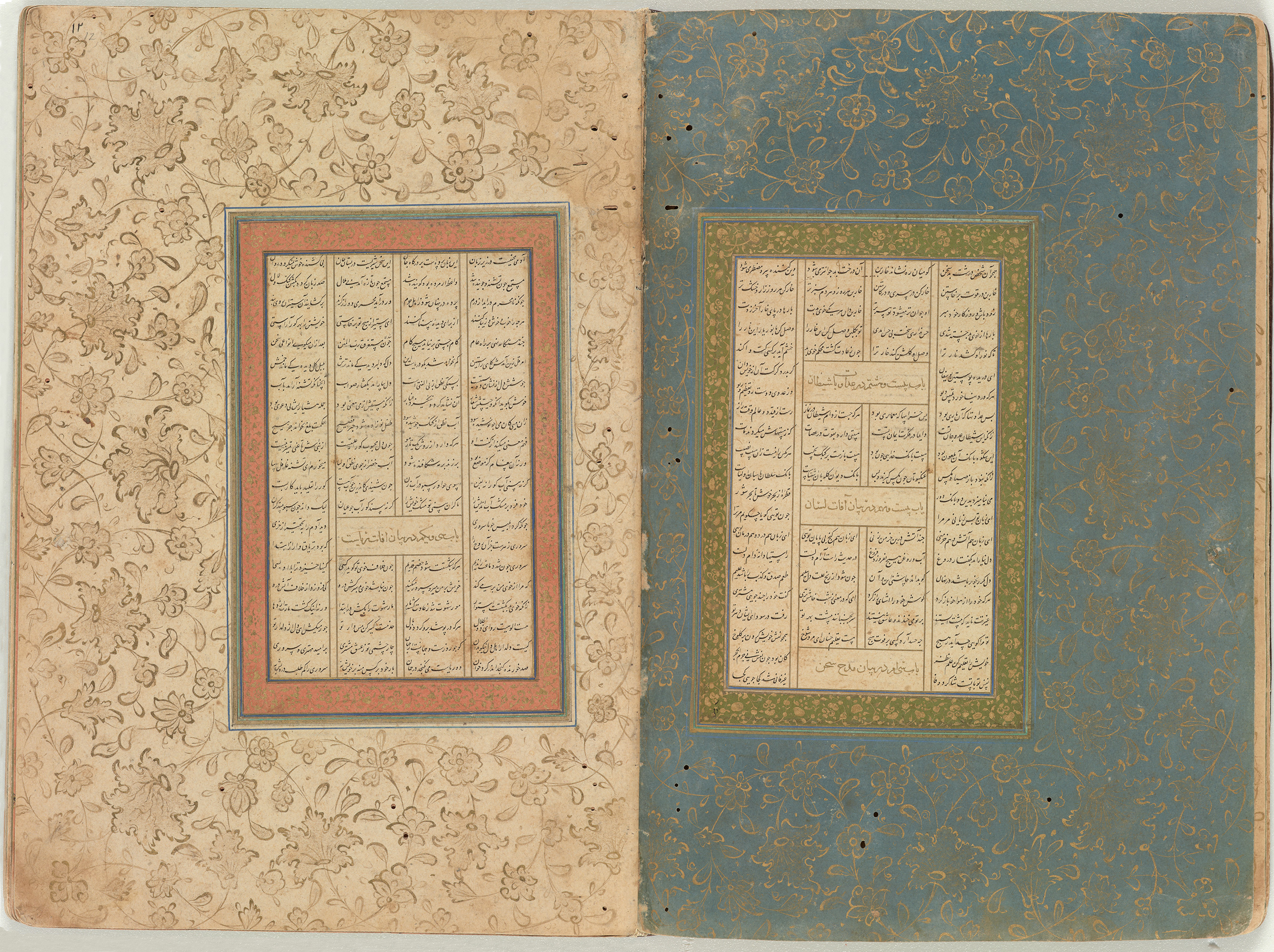He brought the art of the large and small script and the writing of samples to the utmost degree of perfection.
—Qazi Ahmad, Gulistan-i honar, circa 1595
Mir Ali Haravi was one of the most brilliant students of the calligrapher Sultan Ali Mashhadi. He considered himself superior to his master. Asked about the differences between his own calligraphic skills and that of his teacher, Mir Ali replied, “I brought it to perfection but his writing had a special flavor.” Although he is often compared to his celebrated instructor, authors of treatises on calligraphy do not necessarily agree that he surpassed Sultan Ali Mashhadi. It is generally accepted, however, that Mir Ali initiated a new canon of nasta‘liq, especially in the genre of large-scale qit‘as, or fragments of poetry. Hundreds of qit’as with the signature of this extremely prolific calligrapher are known, but many of the works were in fact penned by his students. In an unusual move for a renowned artist, Mir Ali allowed his pupils to sign their well-executed pieces with his name.
Raised in Herat, Mir Ali worked in the royal workshops of the Timurid and then the Safavid dynasty. He witnessed the Uzbek seizure of Herat in 1528. Forced into exile in Bukhara, Mir Ali served Ubaydallah and Abd al-Aziz, khans of the Shaybanid dynasty, until his death around 1550. In the numerous poetic verses he composed in Persian and Turkic, Mir Ali Haravi often lamented the cruelty of destiny and the fact that he would never visit Herat again.

Large-scale folios in nasta‘liq became popular at the turn of the sixteenth century in Iran and in the Persian-speaking sphere. Calligraphers initially created these individual pages, called qit‘as (meaning both fragments of poetry and calligraphic samples), as exercise sheets, or mashq. Each qit‘a normally consists of a quatrain arranged in four diagonal lines in the central zone. The verses were in fact originally written horizontally in a type of nasta‘liq known as jali, a large form of the script with exaggerated characteristics, such as elongated strokes and dramatic variations in width. The name of the calligrapher usually appears in the lower left triangle, as it does here. In contrast with the monumental central panel, cartouches with unrelated verses, composed in small script (khafi), enliven the borders.
Decades after these lines of Persian poetry were written, connoisseurs in Mughal India collected such highly prized qit‘as and had them mounted on the diagonal—to heighten their dramatic visual effect—with ornate borders. The elaborate folios were then assembled in albums that still remain hallmarks of Mughal artistry.
Signed by Mir Ali Haravi (d. ca. 1550)
Uzbekistan, probably Bukhara, Shaybanid period, ca. 1530–40
Borders: India, Mughal period, ca. 1630–60
Ink, opaque watercolor, and gold on paper
Purchase
Freer Gallery of Art F1939.50b

Text blocks in Persian manuscripts typically present verses displayed in two parallel columns, with the colophon appearing at the very end of the volume. The placement of Mir Ali’s signature on the penultimate line suggests this page of poetry was initially conceived as a stand-alone folio. The verses were written by Amir Shahi, a minor Persian poet who was active during the Timurid period and died in 1453. His poems frequently appear among works selected for display in Mughal albums, and he seems to have been one of Mir Ali Haravi’s favorite poets.
Some of Shahi’s verses that Mir Ali copied in large-format qit‘as were included in an album assembled for the Mughal emperor Shah Jahan (reigned 1628–58) in India. All but one of the signed calligraphies in that album are said to have been done by Mir Ali Haravi. Their authenticity remains uncertain, however, since Mir Ali authorized his most brilliant students to sign their pieces with his name. Imitation (naql) was an elemental part of a calligrapher’s education. One of a student’s main goals was to attain the ability to reproduce the master’s style in an indistinguishable way.
Signed by Mir Ali Haravi (d. ca. 1550)
Historic Iran, present-day Afghanistan, Herat, or Uzbekistan, Bukhara, Safavid or Shaybanid period, ca. 1525–45
Borders: India, Mughal period, ca. 1650–58
Ink, opaque watercolor, and gold on paper
Purchase—Smithsonian Unrestricted Trust Funds, Smithsonian Collections Acquisition Program, and Dr. Arthur M. Sackler S1986.92

These calligraphic fragments in different scales of nasta‘liq script were seemingly executed by Mir Ali Haravi. The quatrain was written by the celebrated fourteenth-century poet Hafiz, while the verses in small script to the side and bottom are excerpted from a collection of poetry by Amir Shahi. Pieces signed by the esteemed calligrapher Mir Ali were integrated into a sumptuous album of illuminated folios for the Mughal emperor Jahangir, who reigned from 1605 to 1627. The marginal images of saints and Madonna with Child, based on European prints, date from this time and are not related to the text. Assembled in India, the so-called Gulshan Album is still regarded as one of the most famous Mughal albums ever produced.
The original qit‘a (fragment of poetry) may have been intended to flatter a royal patron. It reads:
O Emperor, may your holiday be happy and blessed.
May the desire of your soul always laugh like the lip of the goblet.
May the regal horseman of your fortune be astride the polo steed;
When you strike the heavens with your mallet, may it be humbled.
Signed by Mir Ali Haravi (d. ca. 1550)
Probably Uzbekistan, Bukhara, Shaybanid period, ca. 1540
Borders: India, Mughal period, ca. 1590–1600
Ink, opaque watercolor, and gold on paper
Purchase
Freer Gallery of Art F1956.12

This collection of poems includes four sections by different master calligraphers, each of whom followed the style of Sultan Ali Mashhadi. In Herat, Mir Ali Haravi penned the first section of the manuscript that consists of a selection of verses from the Mathnavi-yi ma‘navi (Rhyming couplets of spiritual meaning) by the renowned author Jalal al-Din Rumi, who died in 1273.
Mir Ali Haravi mastered the nasta‘liq script in the microscopic form, seen here, and in the larger size that was used for works later mounted into albums. Despite the script’s minute size, he perfectly rendered the intrinsic fluid character of nasta‘liq by using at least one elongated stroke in each line.
Signed by Mir Ali Haravi (d. ca. 1550)
Historic Iran, present-day Afghanistan, Herat, Safavid period, dated 1524–25 (930 AH)
Ink, color, and gold on paper
Purchase
Freer Gallery of Art F1944.48

